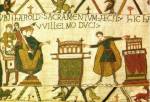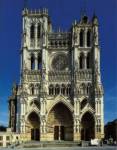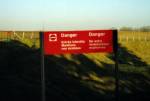After the Americans entered World War 2 in December 1941, Hitler grew concerned about an invasion so he ordered the construction of the Atlantic Wall, a system of 15,000 gun emplacements and obstacles along the coast all the way from Denmark to Spain. Fortunately for the Allies, it was not quite complete for D-Day, the 6th of June 1944, when they surged ashore on the Normandy beaches.
We visited Omaha Beach which had been assigned to the Americans. Although they suffered terrible losses, they broke through and were over the beach before noon. I'm often critical of American foreign policy but this was America’s finest hour, demonstrating what it means to fight for freedom. I had to fight back tears after reading the inscription on the memorial:
1st US Infantry Division
No mission too difficult.
No sacrifice too great. Duty first.
Forced Omaha Beach at dawn 6 June
The Atlantic Wall failed but establishing a foothold was not going to win the war. The Allies needed to get whole Armies ashore and though there are many excellent French ports, they knew that the Germans would destroy them as they retreated. The Allies would have to build their own.
They chose the nearby fishing village of Amaranches. On D-Day, 17 old ships were sunk offshore to provide an immediate breakwater so smaller boats could start unloading. 115 huge concrete barges were towed from England across the Channel and sunk further out to form a solid breakwater 6 km/4 miles long, then prefabricated dock facilities were positioned. Forty ships could unload at once. In the six days after D-Day, 326,000 men, 54,000 vehicles from Jeeps to battle tanks and 110,000 tons of supplies were brought ashore. A small museum explains it well.
As we drove on to Caen to find the hotel, I reflected on the ferocious battles fought across this area within the lifetime of some still living here.
In the evenings, Lan generally fell asleep early and I would watch TV. Benny Hill reruns needed no translations and I enjoyed French soccer. That evening, the Nantes' goalkeeper Landreau made a sensational save from a penalty shot taken by Brazilian star Ronaldinho playing for Paris.
One of the highlights of the trip was the Bayeux Tapestry. I had seen it in 1983 but had no memory of it. It is essentially a 900-year-old cartoon telling the story of how William of Normandy became William the Conqueror at the Battle of Hastings in 1066. It is in stunning condition given its age.
We visited Amiens to see the magnificent cathedral and I wanted to visit the site of ghastly WW1 Battle of the Somme where over a million died fighting for very little.
I've pondered how long we remember a war and concluded as long as survivors are still alive. The Napoleonic Wars changed Europe just as drastically, yet I feel no link with them. The very last survivors of WW1 are dying now and that chapter of history is closing. A hundred years from now, the trenches will be barely distinguishable, the evidence gone.





